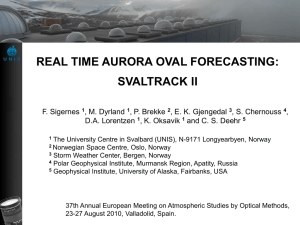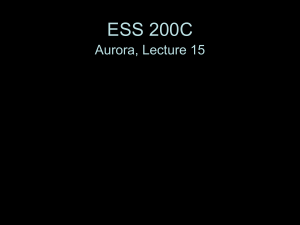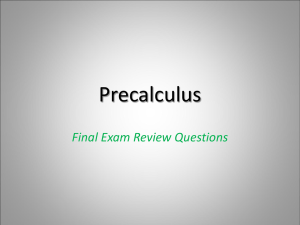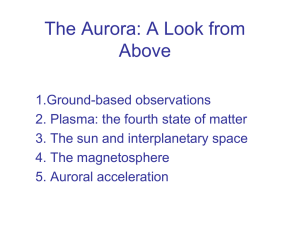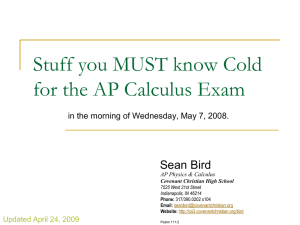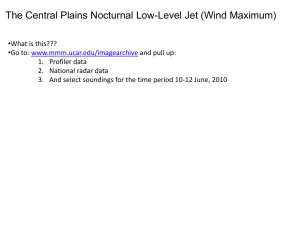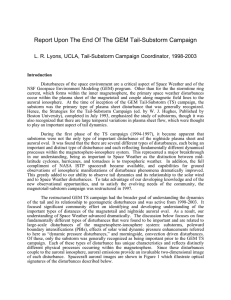pptx - UNIS
advertisement
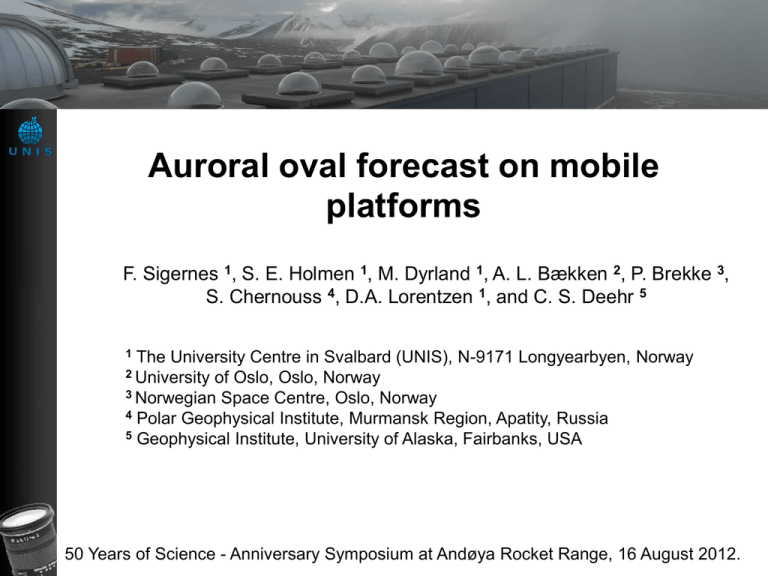
Auroral oval forecast on mobile platforms F. Sigernes 1, S. E. Holmen 1, M. Dyrland 1, A. L. Bækken 2, P. Brekke 3, S. Chernouss 4, D.A. Lorentzen 1, and C. S. Deehr 5 1 The University Centre in Svalbard (UNIS), N-9171 Longyearbyen, Norway of Oslo, Oslo, Norway 3 Norwegian Space Centre, Oslo, Norway 4 Polar Geophysical Institute, Murmansk Region, Apatity, Russia 5 Geophysical Institute, University of Alaska, Fairbanks, USA 2 University 50 Years of Science - Anniversary Symposium at Andøya Rocket Range, 16 August 2012. 2 MATEMATICAL REPRESENTATIONS OF THE AURORAL OVALS METHOD A: The Feldstein-Starkov ovals Poleward and equatorward boundaries of auroral oval in geomagnetic co-latitude: p or e A 0 A1 cos 15 t 1 A 2 cos 15 2 t 2 A3 cos 15 3 t 3 , where amplitudes Ai and phases i is given by Ai or i b 0 b1 log 10 AL b 2 log 2 10 AL b 3 log 3 10 AL . The AL index is the max negative excursion of the H component from several ground based magnetometers. It relates to the planetary Kp index by AL 18 12 . 3 K p 27 . 2 K 2 p 2K 3 p REFERENCES [1] Starkov, G. V., Mathematical model of the auroral boundaries, Geomagnetism and Aeronomy, 34, 3, 331-336, 1994. [2] Starkov, G. V., Statistical dependences between the magnetic activity indices, Geomagnetism and Aeronomy, 34, 1, 101-103, 1994. 2 MATEMATICAL REPRESENTATIONS OF THE AURORAL OVALS METHOD B: The Zhang-Paxton ovals The electron energy flux is derived from GUVI imager data (TIMED satellite) Qm 1 exp x A / A A 0 m exp x A1m / A 2 m 2 1m , 3m where x is co-magnetic latitude. x /2 The coefficients A’ is are calculated as n t n t b cos b sin n m 12 n m 12 n 1 6 A im b 0 m . The coefficients b’ is tabulated as a function of six sub-intervals (m) of Kp index. REFERENCE [3] Zhang Y., and L. J. Paxton, An empirical Kp-dependent global auroral model based on TIMED/GUVI data, J. Atm. Solar-Terr. Phys., 70, 1231-1242, 2008. GEOGRAPHICAL TRANSFORM Cartesian components: x m sin cos 2 t / 24 ( t ) y m sin sin (t ) - is the longitudinal difference between the sub-solar point and the magnetic poles at time t (hours). z m cos Geographical coordinates: x cos 0 cos y sin 0 cos z sin Latitude and longitude: sin 0 cos 0 0 cos 0 sin x m sin 0 sin y m z m cos cos 1 (z) 2 tan 1 ( y / x) 0 82 . 41 N o 0 82 . 86 E o / 2 0 x0 x0 VISUALIZATION The ovals are visualized with a stand alone 32-bit executable Windows program called SvalTrackII. The program is written in Borland Delphi 5 – Pascal and uses a Geographic Information system (GIS) unit called TGlobe. The twilight zone, night- and dayside of the Earth are projected with grades of shade on the Globe as a function of time. Includes: Method A (1) Equatorward boundary of the diffuse aurora (2) Feldstein & Starkov oval (3) Field of view aurora observer Method (B) (4) Zhang & Paxton oval (5) Observer location (6) Moon and Sun information at local site VISUALIZATION All-Sky Satellite View Local auroral oval & satellite all-sky view Based on Feldstein & Starkov and TLE element SGP4 code by [4] [4] Vallado, D. A., P. Crawford, R. Hujsak, and T. S. Kelso, Revisiting Space track Report #3, American Institute of Aeronautics and Astronautics (AIAA), Report No. AIAA 2006-6753, 1-88, 2006. NEW! All-Sky Star View Local auroral oval & star map all-sky view Based on Feldstein & Starkov ovals and Sky Charts software by [5] Catalog: BSC5 [5] Cartes du Ciel, http://www.ap-i.net/skychart/ ANIMATION Animated aurora ovals as a function of Kp index [0…8] at 08:50 UT, 24th December 2009 MODEL COMPARISION Kp Auroral activity Level 0 Very low 1 Low 2 Low normal Low normal conditions 3 A∩B [%] B∩C [%] Q max [mW/m2] 99 1.65 26 86 2.10 33 87 3.20 Normal 35 87 4.34 4 Calm storm 36 89 5.34 5 Minor storm 35 88 6.45 6 Moderate storm 32 84 8.36 7 Strong storm 30 83 12.18 8 Severe storm 24 68 12.91 9 Extreme storm 22 62 18.10 Storm conditions 32 Auroral intersections: (A) Zhang-Paxton, (B) Feldstein-Starkov and (C) Equatorward boundary of diffuse aurora Qmin= 0.25 ergs cm-2 s-1. THE +1 or +4 HOUR PREDICTED Kp INDEX SOURCE: Space Weather Prediction Centre (SWPC) at the National Oceanic and Atmospheric Administration (NOAA). The Wing Kp predicted Activity Index model. Reference Wing, S., J. R. Johnson, J. Jen, C.-I. Meng, D. G. Sibeck, K. Bechtold, J. Freeman, K. Costello, M. Balikhin, and K. Takahashi, Kp forecast models, J. Geophys. Res., 110, A04203, doi:10.1029/ 2004JA010500, 2005. It is a neural network algorithm that trains on the response of the Kp geomagnetic activity index to solar wind parameters / data. It predicts +1 or+ 4 hours ahead. The model returns an one hour prediction in units of Kp. It updates / predicts every 15 minutes. 15 minutes oval update: http://kho.unis.no http://www.swpc.noaa.gov/wingkp/ THE KHO AURORAL OVAL FORECAST SERVICE Internet Kp index NOAA-SWPC (15 min. updates) SERVER / PC RUNS SVALTRACKII.EXE WEB SERVER http://kho.unis.no Stations x 007 (60 sec.) NEW Weather forecasts YR.NO (60 min.) +1 or +4 hours predictions Mobile Auroral forecast applications (apps) THE KHO MOBILE AURORAL OVAL FORECAST SERVICE Today, as part of the Andøya rocket range 50 years celebration, we now release mobile applications for all smart phones: 1) Android 2) iPhone 3) Windows Phone Company http://appex.no The auroral forecast on a HTC wildfire phone. Some REMARKS and QUESTIONS 1) As expected the Zhang-Paxton ovals deduced by space borne data are wider than the ground based Feldstein-Starkov ovals. 2) In spite of difference in methods and platforms, the model ovals coincide fairly well in shape for low to normal conditions on the nightside. 3) The equatorward border of the diffuse aurora is well defined by both methods on the nightside for Kp<7. 4) On the dayside, there is a need to study further oval shapes for all levels of auroral activity, especially the equatorward border of the diffuse aurora. 5) Is it possible to derive / predict the Kp index from the Norwegian chain of magnetometers, as a real time service? 6) Can other data sources like our new HF radar looking east and future GPS scintillations receiver chains contribute? 7) Optical validation, local light pollution, etc., etc… Acknowledgement We wish to thank 1) The National Oceanic and Atmospheric Administration (NOAA) Space Weather Prediction Centre for allowing us to download the predicted value of the Kp index every 15 minutes. 2) The Research Council of Norway through the project named: Norwegian and Russian Upper Atmosphere Co-operation On Svalbard part 2 # 196173/S30 (NORUSCA2). 3) The Nordic Council of Ministers: Arctic cooperation program # A10162. PS! The Svaltrack II program is fredware…it cost II beers.
